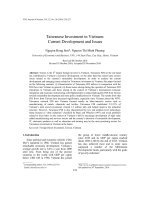Development and Organogenesis
Bạn đang xem bản rút gọn của tài liệu. Xem và tải ngay bản đầy đủ của tài liệu tại đây (792.86 KB, 4 trang )
Development and Organogenesis
Development and
Organogenesis
Bởi:
OpenStaxCollege
The process by which an organism develops from a single-celled zygote to a multicellular organism is complex and well regulated. The regulation occurs through
signaling between cells and tissues and responses in the form of differential gene
expression.
Early Embryonic Development
Fertilization is the process in which gametes (an egg and sperm) fuse to form a zygote
([link]). To ensure that the offspring has only one complete diploid set of chromosomes,
only one sperm must fuse with one egg. In mammals, a layer called the zona pellucida
protects the egg. At the tip of the head of a sperm cell is a structure like a lysosome
called the acrosome, which contains enzymes. When a sperm binds to the zona
pellucida, a series of events, called the acrosomal reactions, take place. These reactions,
involving enzymes from the acrosome, allow the sperm plasma membrane to fuse with
the egg plasma membrane and permit the sperm nucleus to transfer into the ovum. The
nuclear membranes of the egg and sperm break down and the two haploid nuclei fuse to
form a diploid nucleus or genome.
Fertilization is the process in which sperm and egg fuse to form a zygote. (credit: scale-bar data
from Matt Russell)
1/4
Development and Organogenesis
To ensure that no more than one sperm fertilizes the egg, once the acrosomal reactions
take place at one location of the egg membrane, the egg releases proteins in other
locations to prevent other sperm from fusing with the egg.
The development of multi-cellular organisms begins from this single-celled zygote,
which undergoes rapid cell division, called cleavage ([link]a), to form a hollow ball of
cells called a blastula ([link]b).
(a) During cleavage, the zygote rapidly divides into multiple cells. (b) The cells rearrange
themselves to form a hollow ball called the blastula. (credit a: modification of work by Gray's
Anatomy; credit b: modification of work by Pearson Scott Foresman; donated to the Wikimedia
Foundation)
In mammals, the blastula forms the blastocyst in the next stage of development. Here
the cells in the blastula arrange themselves in two layers: the inner cell mass, and an
outer layer called the trophoblast. The inner cell mass will go on to form the embryo.
The trophoblast secretes enzymes that allow implantation of the blastocyst into the
endometrium of the uterus. The trophoblast will contribute to the placenta and nourish
the embryo.
Concept in Action
Visit the Virtual Human Embryo project at the Endowment for Human Development
site to click through an interactive of the stages of embryo development, including
micrographs and rotating 3-D images.
2/4
Development and Organogenesis
The cells in the blastula then rearrange themselves spatially to form three layers of cells.
This process is called gastrulation. During gastrulation, the blastula folds in on itself and
cells migrate to form the three layers of cells ([link]) in a structure, the gastrula, with a
hollow space that will become the digestive tract. Each of the layers of cells is called a
germ layer and will differentiate into different organ systems.
Gastrulation is the process wherein the cells in the blastula rearrange themselves to form the
germ layers. (credit: modification of work by Abigail Pyne)
The three germ layers are the endoderm, the ectoderm, and the mesoderm. Cells in each
germ layer differentiate into tissues and embryonic organs. The ectoderm gives rise to
the nervous system and the epidermis, among other tissues. The mesoderm gives rise to
the muscle cells and connective tissue in the body. The endoderm gives rise to the gut
and many internal organs.
Organogenesis
Gastrulation leads to the formation of the three germ layers that give rise during
further development to the different organs in the animal body. This process is called
organogenesis.
Organs develop from the germ layers through the process of differentiation. During
differentiation, the embryonic stem cells express specific sets of genes that will
determine their ultimate cell type. For example, some cells in the ectoderm will express
the genes specific to skin cells. As a result, these cells will take on the shape and
characteristics of epidermal cells. The process of differentiation is regulated by locationspecific chemical signals from the cell’s embryonic environment that sets in play a
cascade of events that regulates gene expression.
Section Summary
The early stages of embryonic development begin with fertilization. The process of
fertilization is tightly controlled to ensure that only one sperm fuses with one egg. After
fertilization, the zygote undergoes cleavage to form the blastula. The blastula, which in
some species is a hollow ball of cells, undergoes a process called gastrulation, during
which the three germ layers form. The ectoderm gives rise to the nervous system and
3/4
Development and Organogenesis
the epidermal skin cells, the mesoderm gives rise to the muscle cells and connective
tissue in the body, and the endoderm gives rise to the digestive system and other internal
organs. Organogenesis is the formation of organs from the germ layers. Each germ layer
gives rise to specific tissue types.
Review Questions
The process of gastrulation forms the _______.
1.
2.
3.
4.
blastula
zygote
organs
germ layers
D
Which of the following gives rise to the skin cells?
1.
2.
3.
4.
ectoderm
endoderm
mesoderm
none of the above
A
Free Response
What do you think would happen if multiple sperm fused with one egg?
If multiple sperm fused with one egg, a zygote with a multiple ploidy level (multiple
copies of the chromosomes) would form, and then would die.
4/4









